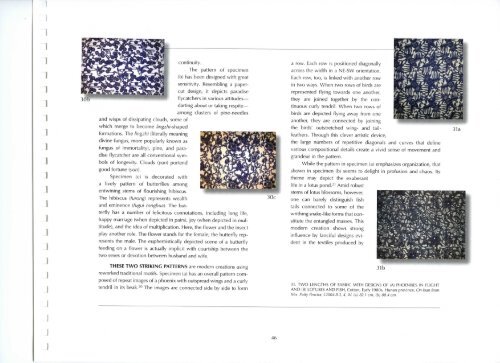Touched by Indigo - Royal Ontario Museum
Touched by Indigo - Royal Ontario Museum
Touched by Indigo - Royal Ontario Museum
Create successful ePaper yourself
Turn your PDF publications into a flip-book with our unique Google optimized e-Paper software.
continuity.<br />
The pattern of specimen<br />
(b) has been designed with great<br />
sensitivity. Resembling a papercut<br />
design, it depicts paradise<br />
flycatchers in various attitudes—<br />
darting about or taking respite—<br />
among clusters of pine-needles<br />
and wisps of dissipating clouds, some of<br />
which merge to become //ngz/?/-shaped<br />
formations. The lingzhi (literally meaning<br />
divine fungus, more popularly known as<br />
fungus of immortality), pine, and paradise<br />
flycatcher are all conventional symbols<br />
of longevity. Clouds (yun) portend<br />
good fortune (yun).<br />
Specimen (c) is decorated with<br />
a lively pattern of butterflies among<br />
entwining stems of flourishing hibiscus.<br />
The hibiscus (furong) represents wealth<br />
and eminence (fugui ronghua). The butterfly<br />
has a number of felicitous connotations, including long life,<br />
happy marriage (when depicted in pairs), joy (when depicted in multitude),<br />
and the idea of multiplication. Here, the flower and the insect<br />
play another role. The flower stands for the female; the butterfly represents<br />
the male. The euphemistically depicted scene of a butterfly<br />
feeding on a flower is actually implicit with courtship between the<br />
two sexes or devotion between husband and wife.<br />
THESE TWO STRIKING PATTERNS are modern creations using<br />
reworked traditional motifs. Specimen (a) has an overall pattern composed<br />
of repeat images of a phoenix with outspread wings and a curly<br />
tendril in its beak.20 The images are connected side <strong>by</strong> side to form<br />
a row. Each row is positioned diagonally<br />
across the width in a NE-SW orientation.<br />
Each row, too, is linked with another row<br />
in two ways. When two rows of birds are<br />
represented flying towards one another,<br />
they are joined together <strong>by</strong> the continuous<br />
curly tendril. When two rows of<br />
birds are depicted flying away from one<br />
another, they are connected <strong>by</strong> joining<br />
the birds' outstretched wing- and tailfeathers.<br />
Through this clever artistic device,<br />
the large numbers of repetitive diagonals and curves that define<br />
various compositional details create a vivid sense of movement and<br />
grandeur in the pattern.<br />
While the pattern in specimen (a) emphasizes organization, that<br />
shown in specimen (b) seems to delight in profusion and chaos. Its<br />
theme may depict the exuberant<br />
life in a lotus pond.21 Amid robust<br />
stems of lotus blossoms, however,<br />
one can barely distinguish fish<br />
tails connected to some of the<br />
writhing snake-like forms that constitute<br />
the entangled masses. This<br />
modern creation shows strong<br />
influence <strong>by</strong> fanciful designs evident<br />
in the textiles produced <strong>by</strong><br />
31. TWO LENGTHS OF FABRIC WITH DESIGNS OF (A) PHOENIXES IN FLIGHT<br />
AND (B) LOTUSES AND FISH, Cotton, Early 1980s, Hunan province, On loan from<br />
Mrs. Patty Proctor, L2004.8.3, 4, W. (a) 82.1 cm, (b) 88.4 cm<br />
31a<br />
46
















